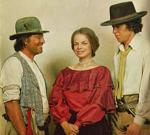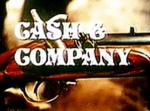AustLit
Latest Issues
AbstractHistoryArchive Description
A bushranging adventure series, conceived by Patrick Edgeworth (a British-born script-writer who had arrived in Australia in 1969 and begun working for Crawford Productions) and Russell Hagg (then script editor for Crawford's Matlock Police) to counteract the comparative absence of historical programs on Australian television. Though the ABC did begin airing Rush shortly before Cash and Company aired, Don Storey notes in Classic Australian Television that 'Unlike Rush, Cash & Company was conceived purely as an escapist adventure series. Although the stories are based on fact, they make no attempt to recreate any authentic events. However, much research was done to ensure the settings, costumes and props faithfully recreated the period'.
The series follows bushrangers Sam Cash and (American) Joe Brady, the sympathetic widow Jessica Johnson, and their nemesis, Lieutenant Keogh. According to Moran, in his Guide to Australian TV Series, Cash and Brady (who have a 'cavalier attitude towards mining licences and other people's sheep') are 'rough diamonds from the wrong side of the track but more masculine and attractive to the horeseriding quasi aristocrat Jessica Johnson than is Keogh'.
However, Storey counters that the 'Contrary to the entry in Moran's Guide To Australian TV Series, Cash & Company is not about their "cavalier attitude to mining licences and other people's sheep".' Instead, he argues, 'Cash & Compan reflects the view that not all outlaws were necessarily bad, but were sometimes reasonable men who were persecuted and driven outside the law by the law itself -- as administered by ruthless officials'.
Storey also notes (in support of this claim) that critics, who were positive about the series, didn't compare it to Rush, but to prior positive depictions of outlaws, such as Butch Cassidy and the Sundance Kid (1969) or the long-running Richard Greene series The Adventures of Robin Hood (1955-1959).
Cash and Company was sold to the United Kingdom, Sweden, Holland, Yugoslavia, Ireland, Norway, and Nigeria, and screened at the Cannes Film Festival. It was successful enough to warrant a second 13-episode series, but Serge Lazaroff's decision to quit the series prompted instead the production of the quasi spin-off Tandarra.
Publication Details of Only Known VersionEarliest 2 Known Versions of
Awards
- 1976 winner Logie Awards — Best New Drama
- Victoria,





